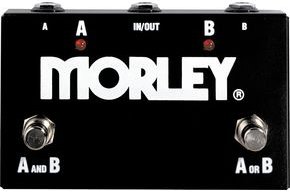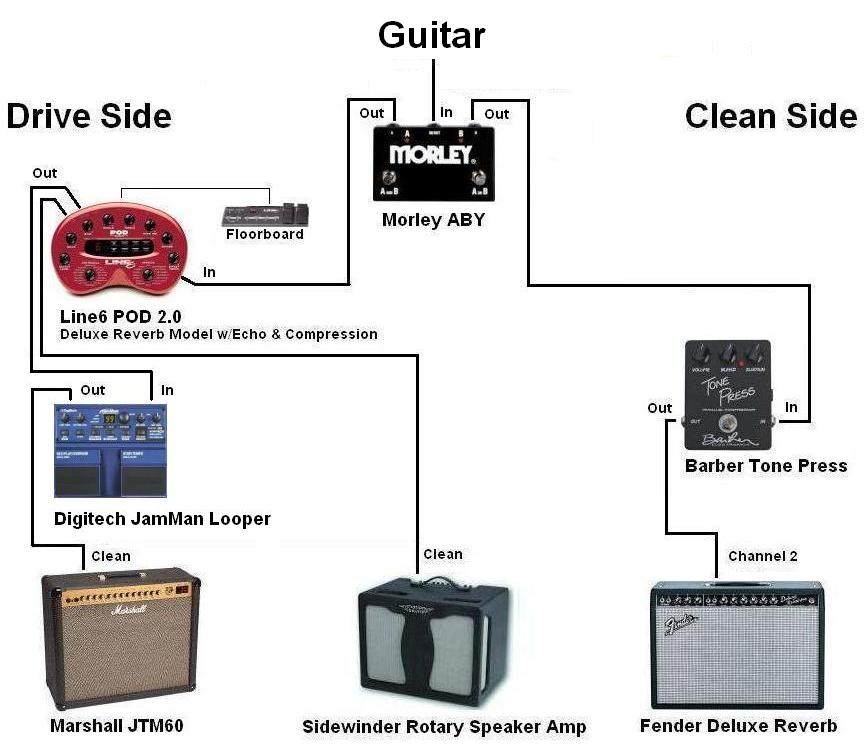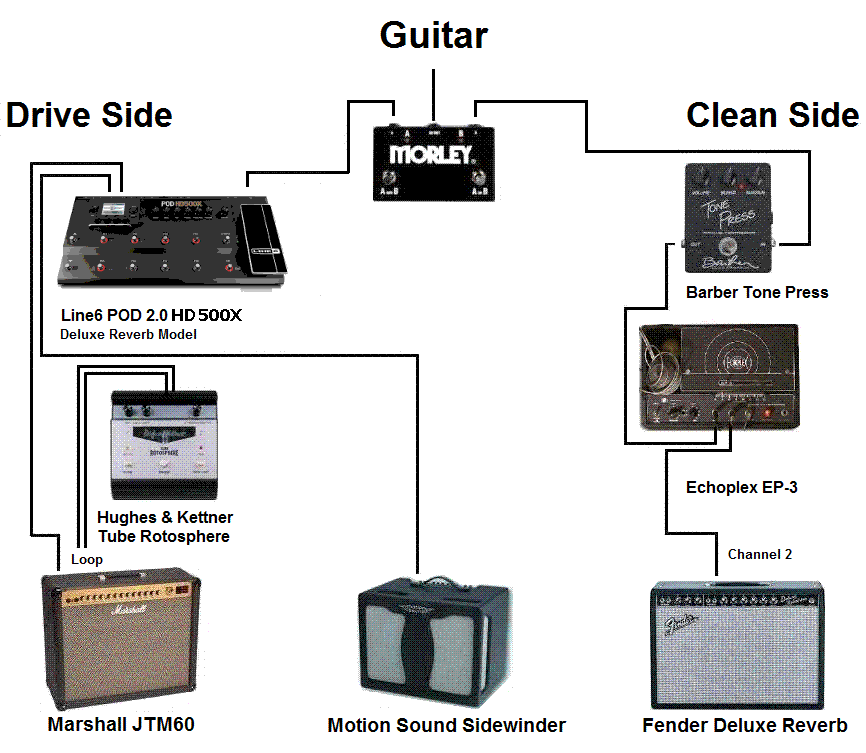Multi-Amping an Electric Guitar
Oh yes, you can have it all... with a little work.
Itís a well-established principle in the electric guitar world: There is no single guitar amp that does it all. Some handle lead and driven sounds well but canít do clean to save their soul. Some do clean but their driven lead sound isnít as tasty. Some surf the brown zone but canít handle either end of the spectrum. And sometimes you just like the sound of more than one amp. In a live situation it can be difficult to get what you want. What to do? Some suffer with one basic range of sound, creating the perfect lead and crunch sound, for example, but not having a good clean sound live. In an attempt to cover all the bases, some people create a huge, complicated pedal train at the front of a single clean amp, allocating various pedals to each sound they want. However, that long train of pedals can create its own set of problems.
I, on the other hand, am a person who prefers as few pedals as possible in the chain before the amp. Iíve always loved the way a guitar sounded clean into the front of an amp and the nuances of the way the preamp interacted with the guitar. I donít like the loading that occurs with longer cord runs and multiple devices in the chain, even the true-bypass lovlies of today. Oh, I might cook the ampís front end a little with a clean boost and I might add a little delay, but my basic sound is very basic: a guitar into an amp. Iíve learned that combinations of different guitars and different amps create very different sounds, and those are the sounds I love. Iíll usually only want maybe two effects at a time, a delay and maybe one modulation effect.
Over time I have experimented with various methods to obtain the sounds Iíve had in my head. One of the first methods was using effects in both the parallel and series effects loops of one amp to add the effects I wanted without preventing the interaction between guitar and preamp that I loved. That was a bit of a mess, with cords running to and from effects to the loops. I had to put some of the effects back by the amp to shorten the cable runs and cut down on clutter. Of course, I couldnít trigger those effects without going back to the amp. The next foreí took me through the POD world, where I discovered some really very cool sounds. Even with the PODís flexibility, though, there were still some holes in the spectrum I was trying to create.
When I was sucked back into guitar after a hiatus to establish my career and start my family, I was really given a boot in the butt by the recordings of Eric Johnson. Listening to the intricate textures he wove with his guitar sounds, I remembered how I had previously spent years honing my basic sound, trying to get it to exactly match what was in my head. I also remembered how I struggled to get both clean and driven sounds onstage. I also remembered how often I was frustrated, finding that goal to be just beyond my reach. I assumed that Eric couldnít get both sounds onstage, that his sound was perfected after the fact for record by overdubbing like everyone elseís. But after seeing a write-up on his rig and recording techniques and then seeing him in person, I was amazed to find out that he often recorded live to tape and then recreated his recorded sound very nearly perfectly live. How? He did it by building multiple signal chains, including amplifiers, and switching between them. Through this I began to see that it was possible to use the various amp and effects chains as components in a complete sound. Eventually, when other methods failed, I gave in to the inevitable and began reasearching a multi-amp rig.
CONNECTIONS...

The Morely ABY - simpliciy itself
But before we get into the rig that resulted, letís deal with some of the necessary equipment and the problems you can encounter with hooking up multiple amps. First, one of the most basic tools in the multi-amp rig is an A/B or A/B/Y switch. They can be very cheap and very basic or incredibly expensive. There are good reasons for every version of them. The most basic version, the A/B switch, simply switches one input between two outputs. In this application, itís typically used to switch one guitar between two amps. In its basic form, it requires three jacks, one switch, a little wire, and a small box to hold it all. Of course, there are always tack-ons, niceties such as LEDs to tell which side you are switched to. Then thereís the question of the ďYĒ, or kitchen sink switch. The ďYĒ option turns the unit into a ďYĒ cord, connecting both amps at once. That adds another switch, possibly an LED, and a little more wire. Most other features are added to deal with problems caused by hooking up more than one amp. Which brings us to:
Grounding: It is not at all uncommon for there to be problems between the grounding schemes of various amps. Weíd all like to simply put our amps on a clean, simple A/B switch and keep the mess, expense, and hassle to a minimum. However, when connected into a switching mechanism, the disparity between two ampsí grounding schemes may turn the resultant wiring into an antenna, attracting all kinds of neat hum and interference. If you have a ground problem, youíll usually have hum and noise. There are two ways to go about limiting the interference: Lifting the ground of the offending amp with a cheater (not recommended for safety, it can present a shock hazared) and isolating the two ampsí inputs from each other electronically. Weíd all like to keep as much as ďironĒ or circuitry out of the system as possible, but this particular problem is best handled by either an input transformer or a buffer amp. There are lots of A/B/Y switches out here that offer a transformer that can be inserted into one leg of the signal path to isolate the grounds. They do the job nicely but they alter the sound of the guitar/amp combo. The trick is to figure out which of your amps or sounds is least affected by the transformer and put it on this leg. That could very well be the most effected leg, by the way. Then thereís:
Phase: It is pretty well known that old Fender amps with two channels feature an odd design anomaly: Channels one and two are out of phase with each other. If you connect a guitar to both channels, they cancel each other out and the volume drops drastically. The same can be true of two amps. If you connect a guitar to two amps, their outputs can be out of phase and can cancel each other out, partially or fully, so that instead of the sound being stronger, it can end up weaker and thinner. Many A/B/Y boxes with a transformer to handle grounding issues also offer a Ďphase reversalí switch. Itís easy to check whether you need to use it: Put the A/B/Y pedal in ďYĒ mode and flip the phase switch back and forth. The position where the signal is thinner, quieter, or harder to localize between the two amps is probably the out of phase position. Youíll want to use the other, in-phase position.
Loading and level: Any time you connect your guitar to an amp, you load its pickups with impedance from the amplifier. If you add an amp, you load the pickup further. The increased load will cause your guitar to sound quieter and thinner. Not good. Thereís a solution to this problem, but it is a compromise. The solution is to place a buffer preamp between the guitar and each of the amps, thus limiting the amount of loading to the amount presented by the buffer preamp. The compromise is that it is virtually impossible to create any preamp that doesnít alter the sound of your guitar to one extent or another. The trick is to find a unit that is salutary to your particular sound. Youíll have to use your ears.

The Radial Big Shot -
An inexpensive ABY with many features
Which brings us back to:
ERIC JOHNSON'S RIG
When I saw him in 2001, here's the rig he was using: Right off the top, heís got a master A/B box that switches between his ďdrivenĒ and ďcleanĒ sides. Lets look at the two sides now:
Clean side: The guitar goes through an Echoplex EP-3 to a T.C. Electronics stereo chorus. One of the stereo outputs of the chorus is fed to a 1965 Fender Deluxe Reverb and the other to a 1971 Fender Deluxe Reverb. End of clean guitar chain. Very clean.
"Driven" side: On the driven side of the first, master A/B box, EricĎs driven side is split again into two separate chains by a second A/B box.
"Driven" Chain number one: The guitar goes through a Butler Tube Overdrive to a 1968 Marshall Tremolo amp. End of driven chain one.
"Driven" Chain number two: The guitar goes to a Dunlop Crybaby Wah, then to a Dallas Arbiter Fuzz Face, and then to a 1967 Marshall 50-watt Plexi Amp. End of driven chain two.
So Eric has three sounds: A stereo clean sound with two amps, a mono driven rhythm sound with one amp, and a mono driven lead sound with another, all accomplished with the shortest signal chain possible before the amp. Now the signal chain moves into the P.A. feed realm. Each of the amps is micíd. The mic signals go to a sub-mixer, where digital and analog delays are added. Those effects are controllable from his pedal board via footswitches. The output of the sub-mixer goes to the PA and to his monitors. If you follow each of the chains, youíll see that there are no more than two effects between his guitar and an amp at any moment. The rest is accomplished via post-amplifier mixing. At any given time heís playing through a very classy, limited guitar-amplifier signal chain. Like any of us guitarists, Eric changes his rig as he goes along. His latest is detailed on his own page, HERE.
MY APPLICATION
Not everyone plays halls large enough or has the crew to justify such a rig. However, by approaching your design problem on a block-by-block basis, you can assemble a nice rig that will accomplish everything you need without being too bulky or complex. Hopefully, by looking at how mine came about, you will be inspired to dream up your own. Here are the parameters within which my rig developed: After years using amps and PODs, I needed a rig that could give me the sounds I needed in three environments: at home in a bedroom, on the stage at moderate band levels, and in the studio. I will never again play at extreme levels. I make my living with my ears and canít afford to be exposed to levels that will damage my ears. If it has to be loud, weíll do it through the PA. In a studio, I can work with mid-level (85-95db) loudness to create the sounds I want without compromise. At home, I must curtail my levels because my small playing room is next to my sonís bedroom and because my wife suffers from chronic migraines that are triggered by sound, among other things.
Here are my building blocks:
1. After years of tweaking, Iíve developed lead and crunch sounds I really like within the POD 2.0. Itís strange, but true. They are based upon a Blackface Fender Deluxe model with reverb, echo, and compression added to various patches for various applications. The sounds are very straightforward but nicely refined. Iíve also discovered that a tube Marshall combo amp does a nice job of reproducing the lead sounds from the POD live without emphasizing hiss.
2. However, the PODís clean sounds arenít as robust and glassy as I might like, especially when reproduced through the Marshall. Thereís a gnarliness I want that I canít quite reproduce in the POD/Marshall chain. Iíve decided I needed a real, clean tube amp for the clean sounds. I especially like the sound when I add a good compressor, in my case, a Barber Tone Press, for sustain. Sometimes Iíll also add an echo to allow me to generate spacey sounds. After experimenting with various amps, I found my match in the 22-watt Fender í65 Deluxe Reverb Reissue. Up to ď5Ē, it is clean, complex, and bright. Now, it can be pushed for a very nice crunch or driven lead, but Iím using it for its clean sound at moderate levels.
3. Iíve always loved the rotating speaker sound and want to integrate it into my system. After monkeying about with pedals, Iíve found the neat little self-contained, 100 watt Motion Sound ďSidewinderĒ rotary speaker amp that sounds great. After experimenting with it, Iíve found that I prefer to use the Sidewinder clean, fed by the driven sound of my POD.
Also, much like David Gilmour, I like to have both a non-rotary and a rotary amp working at the same time because Iíve found that a rotary speaker system used alone often robs me of too much presence when it is in motion.
4. On solo gigs and at home I sometimes work with a Digitech JamMan looper. Iíd like for it to take the output of my POD so that it repeats my complete timbres.
Now, how do I make all this work? Hereís my line chart. To make things simple, follow the chain one line at a time:

In my application, the guitar goes to a Morley A/B/Y box that switches between my "clean" and "driven" sounds. On the clean side, itís just the Barber Tone Press compressor into the Fender Deluxe Reverb. Oh, sometimes Iíll throw in an echo as well, but thatís about the extent of the pedal chain I use on the clean side.
On the driven side of the A/B/Y we feed the input of the Pod 2.0. One of its stereo outputs goes to a Marshall combo amp. When I use the JamMan, Iíll insert it between the POD and Marshall amp. The other output from the POD goes to the Sidewinder amp. Iíve built my rig around combo amps because I like the open-backed sound and because I prefer their small size. Also, Iím not chained into taking the whole she-bangy-bangy out of the barn each time I perform: I can drop the Sidewinder if I donít need the rotary sound or drop the Marshall if I need the rotary but need to cut down on luggage. When all three are present, I line them up in the following physical order, viewing from the house: Sidewinder, Deluxe Reverb, and Marshall. I do this to maximize the spread of the rotary effect onstage. The interface hasn't been exactly clean - I'll probably be shifting to an A/B/Y box with a transformer to eliminate a ground conflict between the Sidewinder and Marshall amps. I'll use the Morely A/B/Y to select between guitars. But the result has been a rig that allows me to get all the sounds I need without compromise or too much clutter.
UPDATE: Recently, I've added a couple of effects back into my mix. I wasn't getting all the Leslie treble horn sound I wanted from the Motion Sound Sidewinder so I tried patching a Hughes & Kettner Rotosphere into the serial loop of the Marshall amp where it works best. I continue to run the clean signal from the POD to the Sidewinder. When they run together, it is Leslie HEAVEN at a quarter of the weight. The Sidewinder provides the physical motion in the room and the Rotosphere provides the Leslie's upper rotor sounds. I've also tracked down an Echoplex EP-3 and placed it in the clean chain between the Tone Press and the Deluxe Reverb to give the classic clean tape echoes. I'm not using the JamMan except at home to practice so it's out of the loop.
UPDATE 2: 04/20/2015 Since I did the diagrams I've moved up to a POD XD500 to replace the red kidney bean. I'm loving its options and faciities. I also vary up the amp in the clean position, sometimes using a reproduction '59 Fender 5E3 Deluxe detailed elswhere on this site. The current rig looks something like this:

I've got some great classic sounds happening now! Good luck in designing and building your own multi-amp rig!
= =
=




